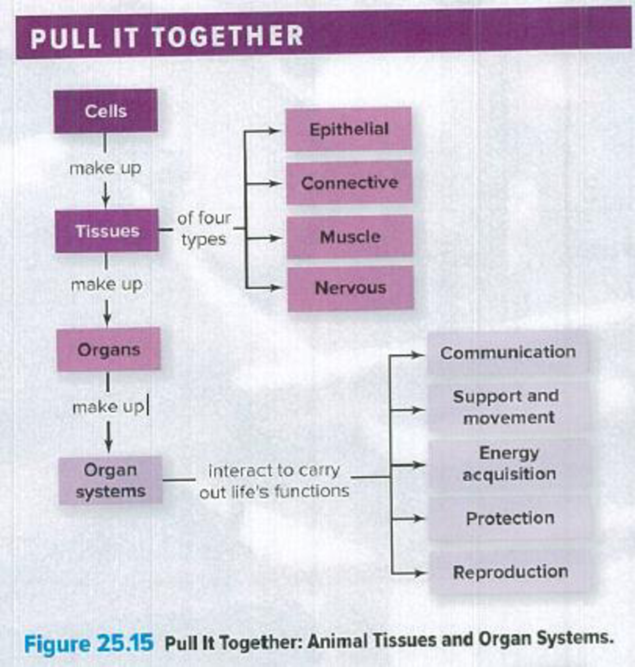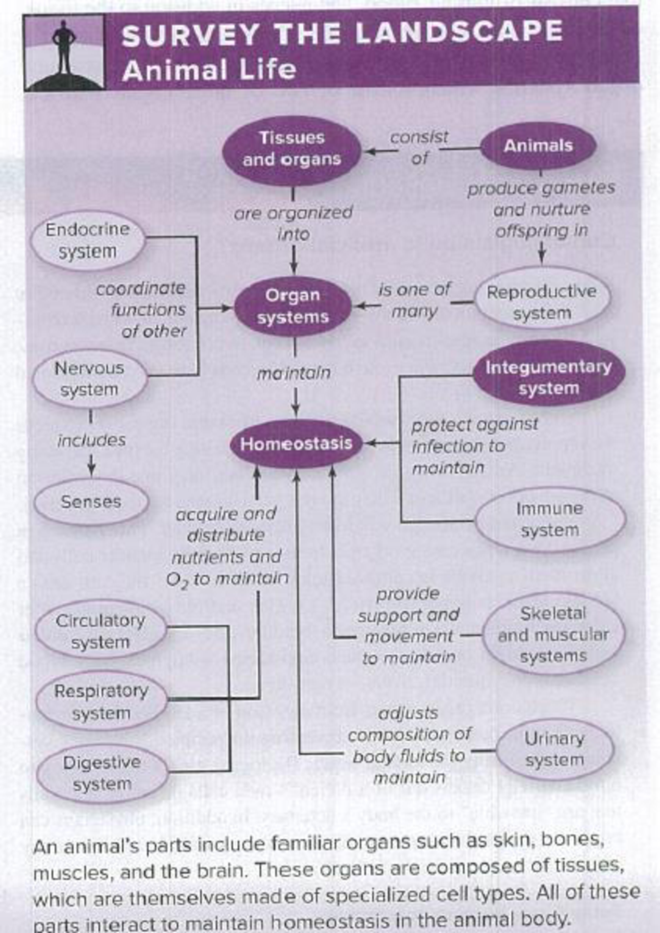
BIOL:CONCEPT+INVEST.ETEXT
5th Edition
ISBN: 9781264154173
Author: Hoefnagels
Publisher: MCG
expand_more
expand_more
format_list_bulleted
Concept explainers
Textbook Question
Chapter 25, Problem 3PIT
Review the Survey the Landscape figure in the chapter introduction, and then connect homeostasis to the concept map in at least two ways. One connection to homeostasis should include a detailed description of how one “life function” (e.g., energy acquisition) maintains homeostasis.


Expert Solution & Answer
Want to see the full answer?
Check out a sample textbook solution
Students have asked these similar questions
Why are nutrient absorption and dosage levels important when taking multivitamins and vitamin and mineral supplements?
I'm struggling with this topic and would really appreciate your help. I need to hand-draw a diagram and explain the process of sexual differentiation in humans, including
structures, hormones, enzymes, and other details.
Could you also make sure to include these terms in the explanation?
. Gonads
. Wolffian ducts
• Müllerian ducts
.
⚫ Testes
. Testosterone
• Anti-Müllerian Hormone (AMH)
. Epididymis
• Vas deferens
⚫ Seminal vesicles
⚫ 5-alpha reductase
⚫ DHT
- Penis
. Scrotum
. Ovaries
• Uterus
⚫ Fallopian tubes
- Vagina
- Clitoris
. Labia
Thank you so much for your help!
Requisition Exercise
A phlebotomist goes to a patient’s room with the following requisition.
Hometown Hospital USA 125 Goodcare Avenue Small Town, USA
Chapter 25 Solutions
BIOL:CONCEPT+INVEST.ETEXT
Ch. 25.1 - What is the difference between anatomy an d...Ch. 25.1 - What is the relationship among cells, tissues,...Ch. 25.1 - Trace the bodys early development from one...Ch. 25.1 - Prob. 4MCCh. 25.2 - If you were given a microscope slide with a slice...Ch. 25.2 - Suppose you determine that a tissue sample...Ch. 25.2 - Prob. 3MCCh. 25.3 - Which organ systems contribute to each of the five...Ch. 25.3 - Prob. 2MCCh. 25.4 - Use figure 25.9 to explain which materials enter...
Ch. 25.4 - Prob. 2MCCh. 25.5 - How does the integumentary system help the body...Ch. 25.5 - Prob. 2MCCh. 25.6 - Prob. 1MCCh. 25.6 - Suggest a specific prediction related to folic...Ch. 25 - Which of the following represents the correct...Ch. 25 - Epithelial tissue consisting of multiple layers of...Ch. 25 - Which of the following features do all types of...Ch. 25 - Prob. 4MCQCh. 25 - Ovaries produce gametes and hormones; these organs...Ch. 25 - Prob. 6MCQCh. 25 - The inner layer of skin is __________, whereas the...Ch. 25 - How does the integumentary system influence...Ch. 25 - Distinguish between the following. a. Organs and...Ch. 25 - Use the Internet to research cosmetic surgery....Ch. 25 - Prob. 3WIOCh. 25 - Explain how you use your organ systems (except...Ch. 25 - Describe how the circulatory system connects the...Ch. 25 - Prob. 6WIOCh. 25 - Prob. 7WIOCh. 25 - Describe at least one interaction between skin and...Ch. 25 - 1. What features distinguish the four types of...Ch. 25 - Prob. 2PITCh. 25 - Review the Survey the Landscape figure in the...
Knowledge Booster
Learn more about
Need a deep-dive on the concept behind this application? Look no further. Learn more about this topic, biology and related others by exploring similar questions and additional content below.Similar questions
- I’m struggling with this topic and would really appreciate your help. I need to hand-draw a diagram and explain the process of sexual differentiation in humans, including structures, hormones, enzymes, and other details. Could you also make sure to include these terms in the explanation? • Gonads • Wolffian ducts • Müllerian ducts • Testes • Testosterone • Anti-Müllerian Hormone (AMH) • Epididymis • Vas deferens • Seminal vesicles • 5-alpha reductase • DHT • Penis • Scrotum • Ovaries • Uterus • Fallopian tubes • Vagina • Clitoris • Labia Thank you so much for your help!arrow_forwardI’m struggling with this topic and would really appreciate your help. I need to hand-draw a diagram and explain the process of sexual differentiation in humans, including structures, hormones, enzymes, and other details. Could you also make sure to include these terms in the explanation? • Gonads • Wolffian ducts • Müllerian ducts • Testes • Testosterone • Anti-Müllerian Hormone (AMH) • Epididymis • Vas deferens • Seminal vesicles • 5-alpha reductase • DHT • Penis • Scrotum • Ovaries • Uterus • Fallopian tubes • Vagina • Clitoris • Labia Thank you so much for your help!arrow_forwardOlder adults have unique challenges in terms of their nutrient needs and physiological changes. Some changes may make it difficult to consume a healthful diet, so it is important to identify strategies to help overcome these obstacles. From the list below, choose all the correct statements about changes in older adults. Select all that apply. Poor vision can make it difficult for older adults to get to a supermarket, and to prepare meals. With age, taste and visual perception decline. As people age, salivary production increases. In older adults with dysphagia, foods like creamy soups, applesauce, and yogurt are usually well tolerated. Lean body mass increases in older adults.arrow_forward
- When physical activity increases, energy requirements increase also. Depending on the type, intensity, and duration of physical activity, the body’s requirements for certain macronutrients may change as well. From the list below, choose all the correct statements about the effects of increased physical activity or athletic training. Select all that apply. An athlete who weighs 70 kg (154 lb) should consume 420 to 700 g of carbohydrate per day. How much additional energy an athlete needs depends on the specific activity the athlete engages in and the frequency of the activity. Those participating in vigorous exercise should restrict their fat intake to less than 15%% of total energy intake. Athletes who are following energy-restricted diets are at risk for consuming insufficient protein. The recommendation to limit saturated fat intake to less than 10%% of total energy intake does not apply to athletes or those who regularly engage in vigorous physical activity.arrow_forwardWhen taking vitamins and vitamin-mineral supplements, how can one be sure they are getting what they are taking?arrow_forwardHow many milligrams of zinc did you consume on average per day over the 3 days? (See the Actual Intakes vs. Recommended Intakes Report with all days checked.) Enter the number of milligrams of zinc rounded to the first decimal place in the box below. ______ mg ?arrow_forward
- the direct output from molecular replacement is a coordinate file showing the orientation of the unknown target protein in the unit cell. true or false?arrow_forwardthe direct output from molecular replacement is a coordinate file showing the orientation of the unknown target protein in the unit cell. true or false?arrow_forwardDid your intake of vitamin C meet or come very close to the recommended amount? yes noarrow_forward
- Which of the following statements about hydration is true? Absence of thirst is a reliable indication that an individual is adequately hydrated. All of these statements are true. Although a popular way to monitor hydration status, weighing yourself before and after intensive physical activity is not a reliable method to monitor hydration. Urine that is the color of apple juice indicates dehydration. I don't know yetarrow_forwardThree of the many recessive mutations in Drosophila melanogaster that affect body color, wing shape, or bristle morphology are black (b) body versus grey in wild type, dumpy (dp), obliquely truncated wings versus long wings in the male, and hooked (hk) bristles versus not hooked in the wild type. From a cross of a dumpy female with a black and hooked male, all of the F1 were wild type for all three of the characters. The testcross of an F1 female with a dumpy, black, hooked male gave the following results: Trait Number of individuals Wild type 169 Black 19 Black, hooked 301 Dumpy, hooked 21 Hooked, dumpy, black 172 Dumpy, black 6 Dumpy 305 Hooked 8 Determine the order of the genes and the mapping distance between genes. Determine the coefficient of confidence for the portion of the chromosome involved in the cross. How much interference takes place in the cross?arrow_forwardWhat happens to a microbes membrane at colder temperature?arrow_forward
arrow_back_ios
SEE MORE QUESTIONS
arrow_forward_ios
Recommended textbooks for you

 Human Biology (MindTap Course List)BiologyISBN:9781305112100Author:Cecie Starr, Beverly McMillanPublisher:Cengage Learning
Human Biology (MindTap Course List)BiologyISBN:9781305112100Author:Cecie Starr, Beverly McMillanPublisher:Cengage Learning- Essentials Health Info Management Principles/Prac...Health & NutritionISBN:9780357191651Author:BowiePublisher:Cengage
 Human Physiology: From Cells to Systems (MindTap ...BiologyISBN:9781285866932Author:Lauralee SherwoodPublisher:Cengage Learning
Human Physiology: From Cells to Systems (MindTap ...BiologyISBN:9781285866932Author:Lauralee SherwoodPublisher:Cengage Learning Biology (MindTap Course List)BiologyISBN:9781337392938Author:Eldra Solomon, Charles Martin, Diana W. Martin, Linda R. BergPublisher:Cengage Learning
Biology (MindTap Course List)BiologyISBN:9781337392938Author:Eldra Solomon, Charles Martin, Diana W. Martin, Linda R. BergPublisher:Cengage Learning



Human Biology (MindTap Course List)
Biology
ISBN:9781305112100
Author:Cecie Starr, Beverly McMillan
Publisher:Cengage Learning

Essentials Health Info Management Principles/Prac...
Health & Nutrition
ISBN:9780357191651
Author:Bowie
Publisher:Cengage

Human Physiology: From Cells to Systems (MindTap ...
Biology
ISBN:9781285866932
Author:Lauralee Sherwood
Publisher:Cengage Learning

Biology (MindTap Course List)
Biology
ISBN:9781337392938
Author:Eldra Solomon, Charles Martin, Diana W. Martin, Linda R. Berg
Publisher:Cengage Learning
What is Homeostasis? | Physiology | Biology | FuseSchool; Author: FuseSchool - Global Education;https://www.youtube.com/watch?v=quQr6X1Q58I;License: CC-BY